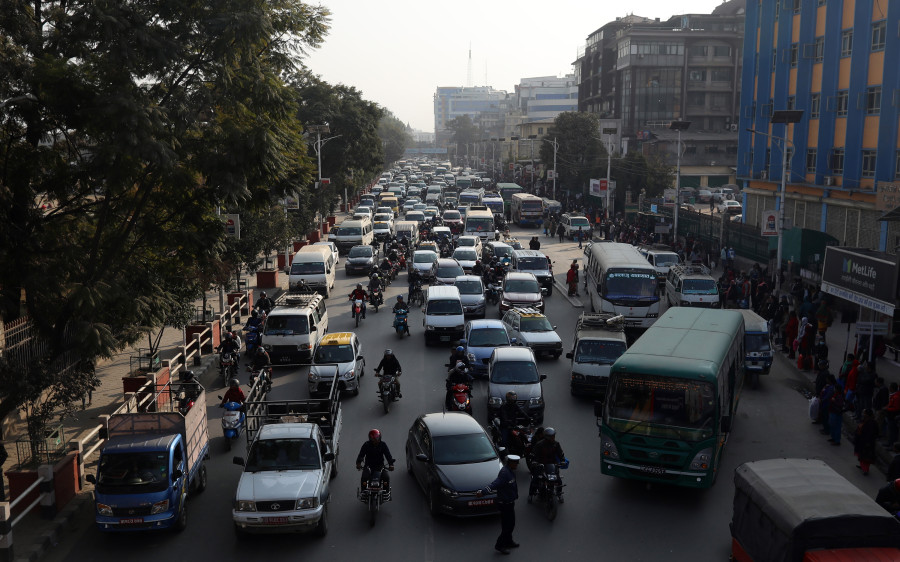Valley
Lack of publicity renders city’s ‘pick and drop’ drive ineffective
The new ‘pick and drop’ rule introduced by the Kathmandu Metropolitan City (KMC) aimed at easing the perennial traffic jams in the Capital’s core areas has not been effective as both drivers and passengers seem unaware about the initiative.
Anup Ojha
The new ‘pick and drop’ rule introduced by the Kathmandu Metropolitan City (KMC) aimed at easing the perennial traffic jams in the Capital’s core areas has not been effective as both drivers and passengers seem unaware about the initiative.
The KMC, in collaboration with the Traffic Police, Department of Roads and Department of Transport Management, implemented the new rules last week in 11 different points including Sundhara, Ratnapark, Bir Hospital, Nepal Airlines, Bhadrakali, Jamal, Pradarshani Marg from where the public vehicles are required to move immediately after dropping and boarding the passengers. These junctions are infamous for traffic jams.
Private buses, micro buses and tempos are the main contributors to the congestion. However, the authority has not placed any signboards or flexes informing about the new rules.
When the Post visited the designated bus stops on Thursday, many public vehicles appeared to have flaunting the rule—waiting for long to pick passengers. Only few traffic police personnel were deployed outside the Nepal Airlines office at New Road gate, Jamal and Bhadrakali, but drivers were reluctant to move their vehicles from the bus stops. The traffic police were not taking any stern action against the vehicles defying the rule, except for blowing whistle and telling them to go.
Chief of the Metropolitan Traffic Police Division SSP Basanta Panta pointed out the poor implementation of the rule.
“It’s KMC’s responsibility to place signboards or flex informing the public about the new campaign. It should have distributed pamphlets and run awareness programmes, but it has done nothing so far,” said Panta.
He lamented that the traffic police could not take any action until everyone concerned is aware of the rules.
“We are at the initial phase. Many of the drivers are not familiar with the new rules,” said Panta, adding that the traffic police would slap a fine up to Rs500 on the rule violating drivers from next week.
And the drivers are having a field day. “I am stopping because I don’t see any traffic police here. Every day, I have to pay Rs1,700 to the bus owner, if I abide by the rules just to pick up and drop passengers, I will make only Rs1,000 a day. That won’t be sufficient to support my family,” said Ram Hari Maharjan, who has been driving a minibus on the Ratnapark-Bhaisepati route for the past four years.
Before the launching of the campaign, Kathmandu Mayor Bidya Sundar Shakya had said the drive was a first step towards making Kathmandu traffic jam-free. He had also announced to mobilise City Police to make the campaign more effective. But City Police personnel were conspicuously absent when this scribe visited those 11 points.
“Often times, I miss my class because the public vehicles wait for passengers for too long. If this drive is effectively implemented, students like me will be benefited and can also save our time,” said Bipana Thapa, 21, a college student in Kalimati.
Town planners have welcomed the move cautiously. “Both the drivers and passengers should get used to it for its smooth implementation, and that requires awareness on the part of both the drivers and commuters,” said former secretary Kishore Thapa.
Despite cynicism about effective implementation of ‘no-horn policy’, the rule seemed to have worked in a crowded city with narrow roads like Kathmandu thanks to better publicity and awareness campaigns.
According to the MTPD data, 1.17 million public vehicles operate daily in Kathmandu Valley, including 13,343 minibuses with less than 20 seats, 12,617 large buses with over 35 seats, 3,802 micros buses and 2,528 tempos, or three-wheelers.




 10.12°C Kathmandu
10.12°C Kathmandu.jpg)









%20(1).jpg&w=300&height=200)

